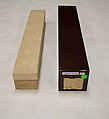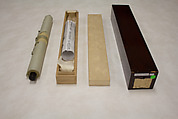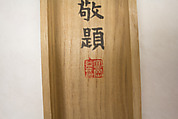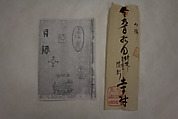Huaisu Writing on a Banana Leaf
Tomioka Tessai Japanese
Not on view
This wonderfully complex composition in ink and light colors by Tomioka Tessai captures a scene of a wizened monk standing in a lush banana grove while using one of the leaves, instead of paper, to practice his calligraphy. An acolyte monk stands behind him attentively holding an inkstone so that his master can replenish his brush as needed. A tall water jar is nearby, for when the brushes need to be rinsed clean. Above the dense growth of banana plants, a gourd used to hold wine hangs from a twisted pine tree, painted in watery ink and a reddish pastel color.
A poem is inscribed above the scene to the left, letting viewers know that the protagonist of the painting is Huaisu (737–799), a Buddhist monk–calligrapher of the Tang dynasty, most famous for his dynamic cursive script. As a monk, Huaisu took a vow of poverty so he could not even afford paper. Instead, he planted banana trees around his residence and used their leaves for practicing calligraphy, as shown here. The inscription in Tessai’s assertive handwriting reads:
人々送酒不曾沽,終日松間挂一壷。
草聖欲成狂便發,真堪畫作醉僧圖。
懷素
People send me wines
that I never resell.
Every day, on a pine,
I hang a jar of wine.
My desire to become a sage of cursive script
drives me to express my madness.
How great it would be if I were portrayed
in a painting as a drunken monk.
—Huaisu
(Translated by Tim Zhang)
The artist Tessai was a renowned Japanese painter and calligrapher who was one of the leading figures of the Bunjinga literati painting style during the Meiji and Taishō periods. He received training in painting from previous generations of Nanga artists and is known as the last literati painter in Japan due to his deep cultivation of literature and art. In addition to fulfilling Huaisu’s dream of being depicted as a drunken monk, he also inscribed Huaisu's verse as a fitting commentary. In no way did Tessai attempt to imitate Huaisu's cursive script style; instead, he wrote the characters in his own idiosyncratic manner, expressing his own obsession with a bolder brand of cursive calligraphy.
Tessai also impressed a Han dynasty “Gun Shiba in” 軍司馬印 (Jun sima yin; military officer’s seal) at the end of his righthand inscription, perhaps to show an antiquarian interest in its archaic “seal script” or perhaps as a foil to the cursive writing styles that he and Huaisu practiced. The seal is impressed following Tessai’s inscription explaining how he obtained this original Han dynasty seal, stating that he impressed this seal every time he wrote in cursive. This paragraph echoes Huaisu’s obsession with cursive script and sheds light on Tessai's own influences and creative process.
This image cannot be enlarged, viewed at full screen, or downloaded.
This artwork is meant to be viewed from right to left. Scroll left to view more.









